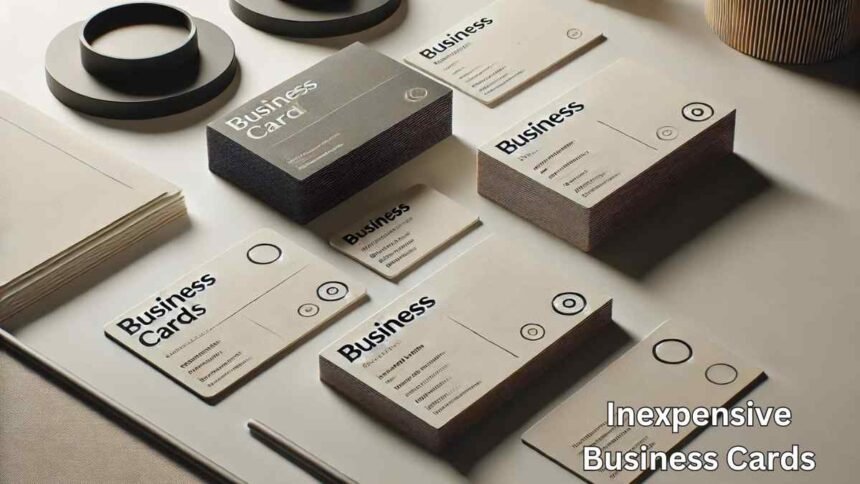Inexpensive business cards can be a game-changer for your brand, offering a cost-effective way to leave a lasting impression on potential clients and partners. By choosing affordable options without sacrificing quality, you can effectively showcase your professionalism and brand identity. Explore various printing techniques, design tips, and materials that ensure your business cards remain both budget-friendly and visually striking.
Introduction
When it comes to networking and making a memorable first impression, business cards are a timeless tool. However, many business owners face the dilemma of balancing quality with cost. Fortunately, inexpensive business cards are now more accessible than ever, allowing you to create high-impact designs without straining your budget. In this article, we’ll delve into strategies for obtaining top-notch business cards at a fraction of the cost, ensuring you never have to compromise on your brand’s image.
Why Business Cards Are Still Relevant
Despite the rise of digital networking, business cards remain a crucial component of professional branding. They provide a tangible connection and a personal touch that digital formats often lack. Business cards serve as a physical reminder of your interaction, making them a valuable tool in face-to-face meetings, conferences, and networking events.
Key Features of High-Quality, Inexpensive Business Cards
When selecting inexpensive business cards, there are several factors to consider to ensure they still reflect the quality and professionalism of your brand. These include:
- Paper Quality: Opt for thicker cardstock to give your business cards a premium feel.
- Design: Keep the design simple yet elegant, focusing on clarity and branding elements like your logo and color scheme.
- Printing Technique: Digital printing is a cost-effective option that can still deliver sharp, vibrant colors.
- Finish: Consider matte or gloss finishes to add a sophisticated touch without significantly increasing costs.
Tips for Designing Affordable Business Cards
Creating business cards inexpensive yet impactful requires a blend of creativity and strategic choices. Here’s how you can design business cards that stand out while keeping costs low:
- Utilize Templates: Many online printing services offer free templates that you can customize to fit your brand’s style.
- Limit Color Usage: Using fewer colors can reduce printing costs while still maintaining a professional look.
- DIY Design Tools: Platforms like Canva allow you to design your cards for free, offering a variety of customization options.
- Focus on Essentials: Keep the information concise—include your name, title, contact details, and logo. This not only keeps your design clean but also reduces the amount of space used, which can lower printing costs.
Affordable Printing Options
When it comes to printing your business cards, there are several affordable options available:
- Online Printers: Companies like Vistaprint and Moo offer competitive prices and frequently run promotions.
- Local Print Shops: Don’t overlook local print shops; they may offer bulk discounts or lower prices for repeat customers.
- Bulk Printing: Ordering in bulk can significantly reduce the cost per card, making it a smart choice for businesses that need a large quantity of cards.
- Digital Printing: This method is often cheaper than traditional offset printing and still delivers high-quality results.
Materials for Cost-Effective Business Cards
Choosing the right materials is crucial in keeping your business cards inexpensive. Here are some budget-friendly options:
- Standard Cardstock: The most common and affordable material, offering a good balance between quality and cost.
- Recycled Paper: An eco-friendly option that can also be more cost-effective, especially if sourced locally.
- Plastic Cards: While generally more expensive, some suppliers offer plastic cards at competitive rates, providing a durable and modern alternative.
Creative Ways to Make Your Cards Stand Out
Even with a limited budget, you can make your business cards unique and memorable:
- Custom Shapes: Opt for rounded corners or a unique shape to make your cards stand out.
- Interactive Elements: Incorporate QR codes that lead to your website or portfolio, adding a digital dimension to your cards.
- Spot UV Coating: Highlight specific areas of your card, like your logo, with spot UV coating to add a subtle yet striking effect.
The Importance of Consistency in Branding
Your business cards should be an extension of your overall brand identity. Ensure that the colors, fonts, and imagery used on your cards are consistent with your other marketing materials. This creates a cohesive brand experience that reinforces your company’s image in the minds of potential clients.
Case Studies: Success Stories with Budget-Friendly Business Cards
Many successful entrepreneurs have launched their brands with inexpensive business cards that didn’t compromise on quality. For example, a freelance graphic designer who used recycled cardstock and minimalistic design was able to convey both creativity and environmental consciousness, attracting clients aligned with those values.
Common Mistakes to Avoid
When aiming to create inexpensive business cards, it’s easy to make mistakes that can detract from your brand. Avoid these common pitfalls:
- Overcomplicating the Design: Too many design elements can make your cards look cluttered and unprofessional.
- Using Low-Quality Images: Always use high-resolution images to avoid pixelation.
- Neglecting Proofreading: Typos and errors can undermine your credibility, so ensure your card is thoroughly proofread before printing.
How to Distribute Your Business Cards Effectively
Having a stack of business cards won’t benefit you if they’re not used strategically. Here are some tips for effective distribution:
- Networking Events: Always have your cards ready at networking events and hand them out during introductions.
- Partnerships and Collaborations: Include your cards in packages sent to potential partners or collaborators.
- In-Store Display: If you have a physical store, place your cards near the checkout area for customers to take.
The Future of Business Cards
As technology advances, the role of business cards may evolve, but their importance is unlikely to diminish. Innovations like NFC (Near Field Communication) enabled cards that transfer contact details directly to smartphones are already emerging, combining traditional networking tools with modern convenience.
Conclusion
Inexpensive business cards don’t have to mean cheap quality. By making informed choices about materials, design, and printing, you can create business cards that effectively represent your brand without breaking the bank. Whether you’re a startup entrepreneur or a seasoned business owner, affordable business cards remain a powerful tool in your marketing arsenal.
For More Visit, Viraltimes.co.uk







